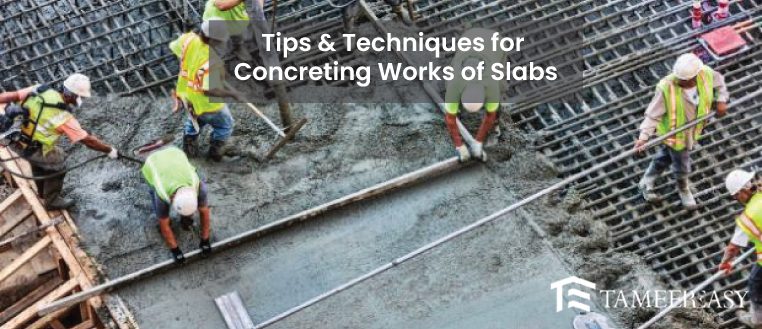The foundation is crucial for building something. A sturdy and long-lasting construction is built on a solid concrete slab. The concreting work of the slab necessitates meticulous planning and execution, whether you’re constructing a residential residence, a commercial building, or an industrial facility.
Here are some essential suggestions and methods to consider before starting your concrete slab concreting project to ensure the success of your endeavour.
Ten Tips & Techniques for Concreting Works of Slabs
A slab’s concreting procedure is more complicated than it first appears. All the areas should have proper materials along with extreme expertise. Any ignored area could result in fractures, uneven surfaces, and structural flaws. We provide a complete guide with ten suggestions and approaches that will put you on the correct track to assist you in producing a beautiful concrete slab.
1), Proper Site Preparation is Key
Be sure the area is well-prepared before you start pouring concrete. Eliminate loose dirt, vegetation, and rubbish. To stop settling, correctly grade the area and compact the soil. A flat and durable slab is built on a foundation of proper site preparation.
2). Compaction is Crucial
Compression is By ensuring the earth is well packed; crucial compaction reduces the possibility of settling and moving. To reach the needed compaction density, use mechanical compactors. This will stop further settling-related fissures from forming.
3). Formwork Must Be Accurate
For the slab’s desired shape and size, well-built formwork is necessary. Before pouring concrete, double-check all measures, angles, and alignment. Formwork should be properly secured to stop leaks and guarantee a smooth surface finish.
4). Reinforcement for Added Strength
Reinforcement such as rebar or mesh should be considered depending on the load the slab will support. The tensile strength reinforcement lowers the likelihood of cracks and increases overall durability.
5). Quality Concrete Mix is Non-Negotiable
It is crucial to use the proper concrete mix. To make sure the mix’s composition is appropriate for the slab’s planned use, speak with a concrete provider. A sturdy, crack-resistant slab benefits from a well-balanced composition.
6). Mindful Pouring and Leveling
Use proper pouring procedures while pouring to prevent air pockets. To release trapped air and guarantee even distribution, use a vibrator. Once you pour the concrete, carefully level it to provide a nice, flat surface.
7). Curing for Optimal Strength
Curing is crucial to the slab’s long-term strength. Cover the concrete with wet burlap, plastic sheeting, or a curing agent to keep it moist for at least seven days. This provides ideal strength development and delays premature drying.
8). Watch Out for Expansion Joints
Implement expansion joints to stop unsightly cracks. Enabling the concrete to expand and contract with changes in temperature reduces the likelihood of surface cracks. Plan where they should go based on the size of the slab and anticipated temperature changes.
9). Timing is Everything
When planning your concrete construction schedule, consider the weather. The curing process can be impacted by extreme heat or cold, which could result in a lower-quality slab. To ensure success, avoid pouring concrete in difficult conditions.
10). Professional Finishing Touches
The slab’s appearance and functioning are greatly affected by the finishing touches. Troweling and edging are effective finishing methods for smooth, non-slip surfaces. To further extend the lifespan of the slab and shield it from moisture, consider sealing it.
Conclusion
It carefully considers numerous elements, from site preparation to final touches, to produce a faultless concreting works of slabs. Ignoring any one step can result in future expensive and time-consuming repairs. These ten guidelines will help you finish your concrete slab concreting project successfully. Remember that putting in the time and effort now will pay off with a strong, long-lasting foundation supporting your structure for many years.








